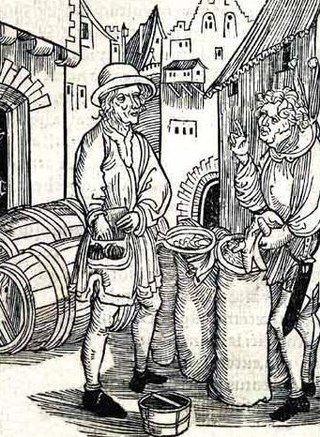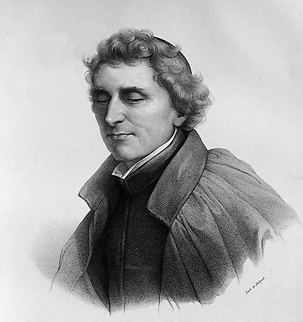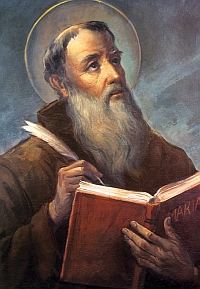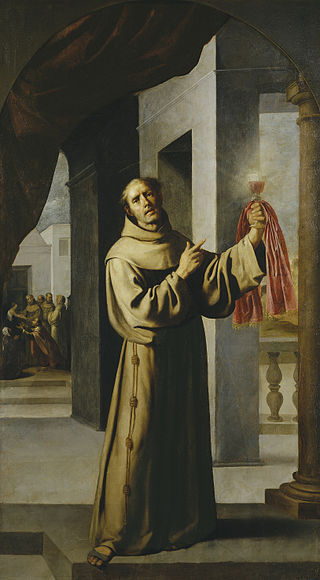
In finance and economics, interest is payment from a borrower or deposit-taking financial institution to a lender or depositor of an amount above repayment of the principal sum, at a particular rate. It is distinct from a fee which the borrower may pay to the lender or some third party. It is also distinct from dividend which is paid by a company to its shareholders (owners) from its profit or reserve, but not at a particular rate decided beforehand, rather on a pro rata basis as a share in the reward gained by risk taking entrepreneurs when the revenue earned exceeds the total costs.

Bernardino of Siena, OFM, also known as Bernardine, was an Italian priest and Franciscan missionary preacher in Italy. He was a systematizer of Scholastic economics. His preaching, his book burnings, and his "bonfires of the vanities" made him famous/infamous during his own lifetime because they were frequently directed against sorcery, gambling, infanticide, witchcraft, homosexuals, Jews, Romani "Gypsies", usury, etc. Bernardino was later canonised by the Catholic Church as a saint – where he is also referred to as "the Apostle of Italy" – for his efforts to revive the country's Catholicism during the 15th century.

Usury is the practice of making unethical or immoral loans that unfairly enrich the lender. The term may be used in a moral sense—condemning taking advantage of others' misfortunes—or in a legal sense, where an interest rate is charged in excess of the maximum rate that is allowed by law. A loan may be considered usurious because of excessive or abusive interest rates or other factors defined by the laws of a state. Someone who practices usury can be called a usurer, but in modern colloquial English may be called a loan shark.

John of Capistrano, OFM was a Franciscan friar and Catholic priest from the Italian town of Capestrano, Abruzzo. Famous as a preacher, theologian, and inquisitor, he earned himself the nickname "the Soldier Saint" when in 1456 at age 70 he led a Crusade against the invading Ottoman Empire at the siege of Belgrade with the Hungarian military commander John Hunyadi.

Louis Bourdaloue was a French Jesuit and preacher.

Lawrence of Brindisi, OFM Cap., born Giulio Cesare Russo, was an Neapolitan Catholic priest, theologian and member of the Order of Friars Minor Capuchin. An accomplished linguist, in addition to his native Italian, Lawrence could read and speak Latin, Hebrew, Greek, German, Czech, Spanish, and French fluently. Lawrence was ordained a priest at the age of 23. Lawrence was beatified on 1 June 1783 and canonized as a saint on 8 December 1881.
Matthew 5:42 is the forty-second verse of the fifth chapter of the Gospel of Matthew in the New Testament and is part of the Sermon on the Mount. This is the fifth and last verse of the antithesis on the command: "Eye for an eye".

A mount of piety is an institutional pawnbroker run as a charity in Europe from Renaissance times until today. Similar institutions were established in the colonies of Catholic countries; the Mexican Nacional Monte de Piedad is still in operation.

Lomazzo is a town and comune in the province of Como, in the Italian region of Lombardy. It is situated halfway between Como and Milan. The ancient historical center of the town was founded on the top of a hill situated in the valley on the right bank of Lura. The municipal territory contains a large portion of the Lura Park. Lomazzo received the title of Città (City) with a presidential decree on July 11, 2006. Lomazzo borders the following municipalities: Bregnano, Cadorago, Cirimido, Guanzate, Rovellasca, Rovello Porro, Turate.

Johannes Pfefferkorn was a German Catholic theologian and writer who converted from Judaism. Pfefferkorn actively preached against the Jews and attempted to destroy copies of the Talmud, and engaged in a long running pamphleteering battle with humanist Johann Reuchlin.

Thomas of Villanova, OSA, born Tomás García y Martínez, was a Spanish friar of the Order of Saint Augustine who was a noted preacher, ascetic and religious writer of his day. He became an archbishop who was famous for the extent of his care for the poor of his see.

Domingo de Soto, O.P. was a Spanish Dominican priest and Scholastic theologian born in Segovia (Spain), and died in Salamanca (Spain), at the age of 66. He is best known as one of the founders of international law and of the Spanish Thomistic philosophical and theological movement known as the School of Salamanca.

Jacob de Marchia, commonly known in English as Saint James of the Marches, was an Italian Friar Minor, preacher and writer. He was a Papal legate and Inquisitor.

Pawnbroking, lending money on portable security, began in ancient history. The practice was widespread in many parts of the world, from ancient Greece to medieval China and medieval Europe.
The subject of loans and interest in Judaism has a long and complex history. In the Hebrew Bible, the Book of Ezekiel classifies the charging of interest among the worst sins, denouncing it as an abomination and metaphorically portraying usurers as people who have shed the borrower's blood. The Talmud dwells on Ezekiel's condemnation of charging interest.
Vix pervenit is an encyclical, promulgated by Pope Benedict XIV on November 1, 1745, which condemned the practice of charging interest on loans as usury. Because the encyclical was addressed to the bishops of Italy, it is generally not considered ex cathedra. The Holy Office applied the encyclical to the whole of the Roman Catholic Church on July 29, 1836, during the reign of Pope Gregory XVI.
Antisemitism in the history of the Jews in the Middle Ages became increasingly prevalent in the Late Middle Ages. Early instances of pogroms against Jews are recorded in the context of the First Crusade. Expulsions of Jews from cities and instances of blood libel became increasingly common from the 13th to the 15th century. This trend only peaked after the end of the medieval period, and it only subsided with Jewish emancipation in the late 18th and 19th centuries.

Bernardine of Feltre was a Friar Minor and missionary, b. at Feltre, Italy, in 1439 and d. at Pavia, 28 September 1494. He is remembered in connection with the monti di pietà of which he was the reorganizer and, in a certain sense, the founder, together with the Michele Carcano. The feast of Blessed Bernardino is kept in the Order of Friars Minor on 28 September.
Barnabas of Terni was an Italian Friar Minor and missionary, who established the first monte di pietà.

Blessed Marco da Montegallo was an Italian Roman Catholic priest from the Order of Friars Minor. He was born to a nobleman and served as a doctor in Ascoli Piceno before he was pressured into marriage in 1451 - the couple annulled their marriage after both entered the religious life. Father Marco is best known for establishing pawnshops for the poor across various Italian cities and for being a preacher of love.

















